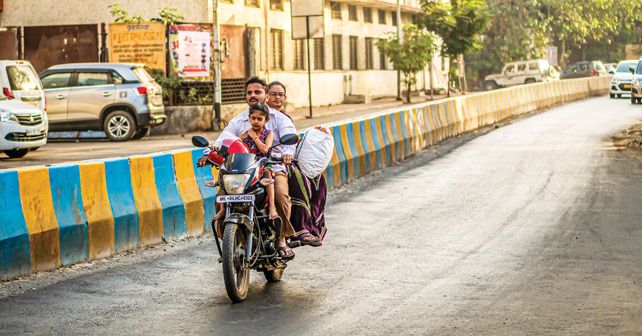
In Mumbai, 93% of traffic fatalities were pedestrians and two-wheeler users. But less than 1% of motorcycle passengers wear helmets correctly. A correctly strapped helmet reduces the likelihood of death by 42%.
Speeding. Drunk driving. Lack of helmet use. Lack of seat-belt use. These four factors impact road safety around the world, especially in cities. Most road fatalities result from these bad habits, and it’s no different in our cities. These fatalities can come down by, among other things, increasing awareness via effective mass communication and strong police enforcement. Also, while I am sure as an enlightened autoX reader you wouldn’t be indulging in these stupid practices, ensure that your friends and family don’t either.
This risky behaviour apart, there is another issue that affects road safety – and that is infrastructure. More often than not, our city roads are built only with vehicles in mind and with the aim of moving them as quickly as possible. This does not take into account other legitimate road users, especially pedestrians. At this point it’s worth repeating this factoid: In Mumbai, pedestrians accounted for over 50% of the road fatalities in 2018. Redesigning our roads and intersections with all these users in mind should help prevent crashes, deaths and injuries.
Last month, I had written about the work done by Bloomberg Philanthropies Initiative for Global Road Safety (BIGRS) in Mumbai, which saw road fatalities come down by 22%. Well, readers pointed out that the Metro work that’s taking place across the city would have contributed to bringing down overall speeds, thus reducing road fatalities. That’s a valid point, but still there were 475 deaths, of which 93% were pedestrians and two-wheeler users (both riders and pillion).
Are there some additional lessons for us on how BIGRS and their partners went about addressing road safety in Mumbai over the last five years? I certainly thought so. I got Kelly Larson, Director, Bloomberg Philanthropies, to share some of their insights. To repeat what I had written earlier, BIGRS places emphasis on clean data. Larson says, ‘Having reliable outcome data is critical to inform road safety policy and action… (We) now have access to timely, detailed road injury data, which focuses on planning and monitoring of efforts.’ She adds, ‘Our areas of intervention are guided by data – which tell us that, overall, Mumbai’s roads are deadliest for pedestrians and motorcyclists and actions should target improving road safety for these groups.’
So how did they go about addressing this? ‘Correct helmet use has been a focus area within the initiative. Proper helmet use – meaning a helmet is worn and strapped – is low in Mumbai, at 33%. Motorcycle passengers are at particular risk: less than 1% of passengers wear helmets correctly. In the event of a crash, using a correctly strapped helmet reduces the likelihood of death by 42%. We have worked closely with the Mumbai Traffic Control Branch to support their work to increase proper helmet use. Recently, the Mumbai Traffic Control Branch ramped up enforcement efforts in coordination with a media campaign that showed the life-saving effects of wearing a helmet and strapping it properly. Efforts like these, coordinating enforcement and mass media, have been shown to improve the behaviour on the road and are working in Mumbai. At the initiative’s start in 2015, only 24% of motorcyclists properly wore helmets. While there is still much progress to be made, the increase to 33% by June 2018 shows that these interventions are working.”
Other than changing risky behaviour, BIGRS also worked with the city authorities, like the traffic police and the municipal corporation, to identify roads and intersections where pedestrians were at higher risk. Several roads and spots across the city were taken up for redesign to ensure people could walk without taking any risks.
So what happens now? ‘We work closely with every city government within the initiative to implement life-saving interventions. By partnering directly with government agencies that address road safety, we aim to engrain best practices into their long-term goals. Our partners within the initiative work to build capacity and expertise within governments, through workshops, technical assistance and practical experience. Many cities have adopted long-term workplans with specific actions agreed upon by relevant agencies to ensure that this work continues. Others have created road safety counsels to oversee the work and create a sense of accountability,’ she says.
‘Mumbai has experienced a 22% decrease in fatalities over the last five years. While this is tremendous progress that has saved lives, there is no quick fix to traffic deaths. Sustained efforts are critical to further decrease road crashes. We also hope to see continued efforts in Mumbai and at the national level to strengthen road safety legislation and enhance vehicle standards.’ We hope so too.
Also read - The 'broken windows' approach could improve India's dangerous road habits
Are films and television a threat to road safety?
Srinivas Krishnan writes about classic and vintage cars for various publications. He is the former Editor of Business Standard Motoring & former Head of Press, Porsche India.























Write your Comment